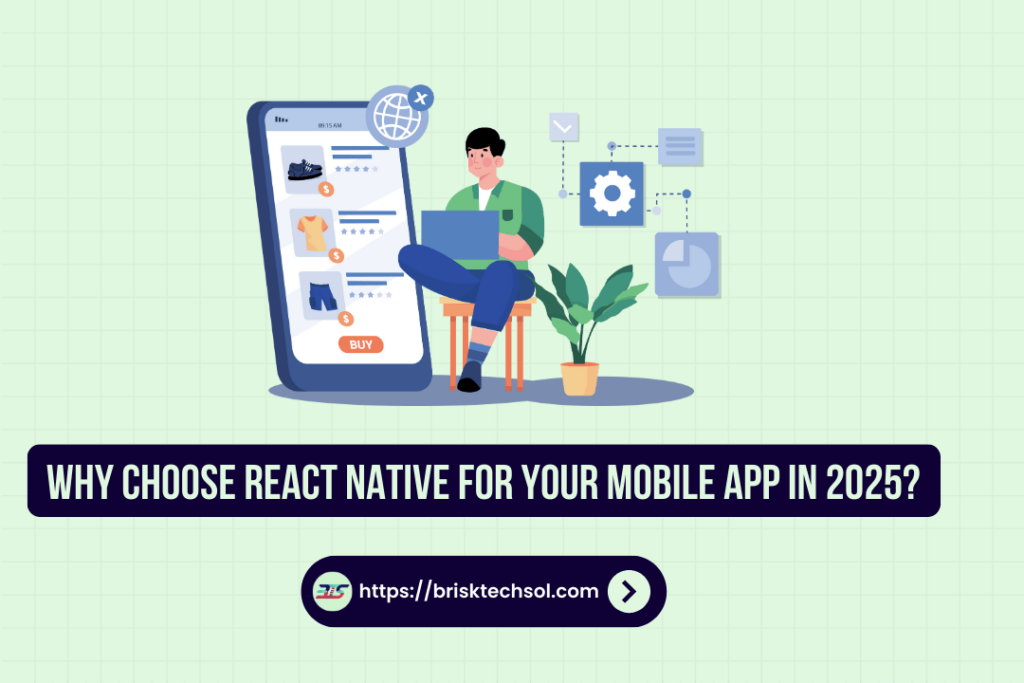Imagine launching a mobile app that works flawlessly on both iOS and Android from a single codebase saving time, reducing costs, and accelerating your go-to-market strategy. In 2025, React Native remains a top choice for businesses aiming to deliver high-performance, cross-platform applications quickly. This guide explores the compelling reasons to choose React Native for your next mobile app.
What Is React Native?
React Native is an open-source framework developed by Facebook that enables developers to build mobile applications using JavaScript and React. It allows you to write one codebase and deploy it on multiple platforms, significantly cutting down development time and cost while delivering near-native performance.
Key Points:
- Cross-Platform Development: Single codebase for iOS and Android.
- JavaScript and React: Leverages popular, widely supported technologies.
- Open Source: Constantly improved by a large global community.
Benefits of React Native for Mobile App Development
React Native offers a wide range of advantages that make it appealing for mobile app development in 2025. These benefits touch on cost, speed, performance, and community support.
Accelerated Development and Faster Time-to-Market
By using a single codebase, teams can significantly reduce development time. This means:
- Rapid Prototyping: Quickly build and test app features.
- Faster Iteration: Make updates and improvements faster than developing native apps separately.
- Unified Development: Streamlined workflow reduces overhead, making it easier to launch updates across platforms simultaneously.
Cost Efficiency
Developing with React Native typically requires fewer resources:
- Reduced Development Costs: One codebase for iOS and Android cuts labor expenses.
- Lower Maintenance Costs: Updates are applied once, reducing long-term maintenance expenses.
- Efficient Resource Utilization: Reusable components and shared logic lower development redundancy.
Near-Native Performance
Thanks to its architecture, React Native delivers performance close to native apps:
- Optimized User Experience: Smooth animations and interactions.
- Native Modules: Ability to integrate native code for complex tasks.
- Responsive Interfaces: Fast load times and efficient resource management ensure a seamless user experience.
Vibrant Community and Ecosystem
The strength of React Native lies in its large, active community:
- Extensive Libraries: A wealth of third-party libraries and plugins to speed up development.
- Continuous Improvement: Regular updates and contributions from the global developer community.
- Rich Documentation: Comprehensive guides, tutorials, and support forums ease the learning curve.
Comparison with Other Mobile App Development Frameworks
React Native isn’t the only cross-platform option available. Here’s a quick comparison with some other popular frameworks:
| Aspect | React Native | Flutter | Xamarin |
|---|---|---|---|
| Language | JavaScript/TypeScript | Dart | C# |
| Performance | Near-native performance | High performance with custom UI | Native-like, but integration can be complex |
| Community & Ecosystem | Extensive and mature | Growing rapidly | Strong Microsoft backing |
| Ease of Use | Moderate learning curve | Requires learning Dart | Familiar for .NET developers |
| Cost Efficiency | Lower due to a single codebase | Comparable | Typically higher due to licensing |
React Native’s balance of performance, community support, and cost efficiency often makes it the preferred choice for many development teams.
Key Features of React Native
React Native offers several features that make it stand out:
- Reusable Components: Build modular, maintainable code that can be reused across projects.
- Hot Reloading: See changes instantly without restarting the app.
- Third-Party Plugins: Easily integrate with existing native modules and APIs.
- Native Modules: Bridge between JavaScript and native code for enhanced performance.
- Cross-Platform Consistency: Ensure a uniform look and feel across both iOS and Android.
Challenges and Considerations
Despite its many benefits, React Native comes with challenges that must be considered:
Performance Trade-Offs
While React Native offers near-native performance, it may sometimes require additional optimization when handling graphics-intensive or highly interactive applications. Integrating native modules can mitigate these issues but may increase development complexity.
Learning Curve and Expertise
Developers need a good understanding of JavaScript, React, and native development concepts. For teams new to these technologies, the initial learning curve can be steep.
Platform-Specific Limitations
Though React Native covers most use cases, certain platform-specific features might require native development. Balancing cross-platform consistency with platform-specific optimizations can be challenging.
Conclusion
In 2025, React Native remains a powerful framework for building high-quality, cross-platform mobile apps. Its ability to reduce development time and cost while delivering near-native performance makes it a compelling choice for startups, enterprises, and everything in between. With a robust ecosystem, active community, and continuous innovation, React Native is best to drive mobile app success for years to come.
FAQs
1. What is React Native?
React Native is an open-source framework that enables cross-platform mobile app development using JavaScript and React.
2. Why choose React Native over native development?
It allows you to develop one codebase for both iOS and Android, reducing development time and cost while maintaining near-native performance.
3. How does React Native perform compared to other frameworks?
React Native offers a good balance of performance, cost efficiency, and community support compared to Flutter and Xamarin.
4. Can I integrate native modules in React Native?
Yes, React Native supports native modules, allowing you to bridge JavaScript code with native APIs for enhanced functionality.
5. Is React Native suitable for large-scale enterprise apps?
Absolutely. Many enterprises use React Native for both customer-facing and internal apps due to its scalability and cost-effectiveness.









